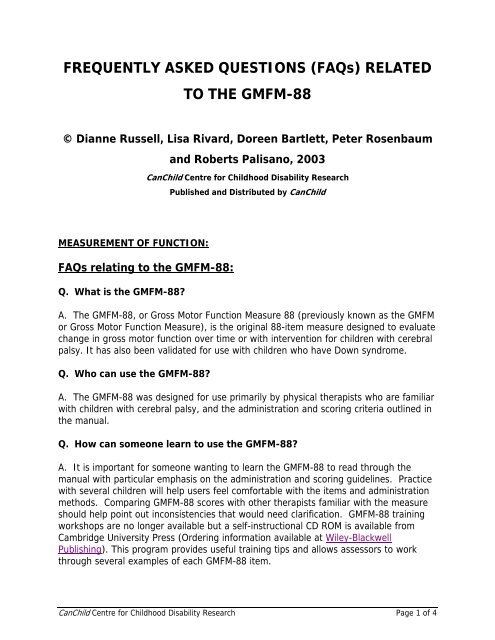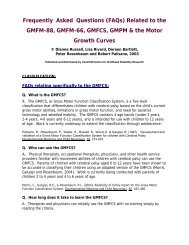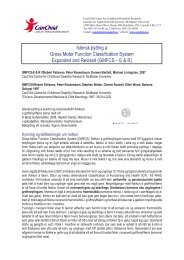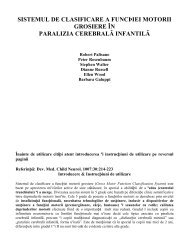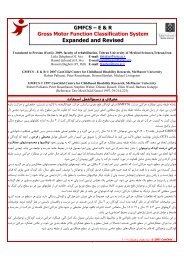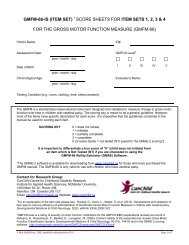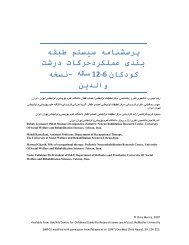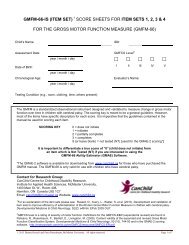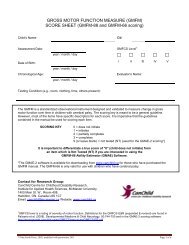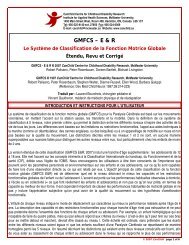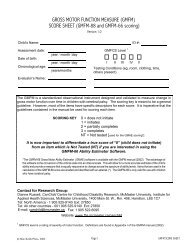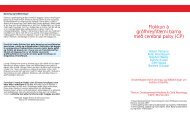GMFM-88 - Motor Growth Measures - CanChild Centre for ...
GMFM-88 - Motor Growth Measures - CanChild Centre for ...
GMFM-88 - Motor Growth Measures - CanChild Centre for ...
You also want an ePaper? Increase the reach of your titles
YUMPU automatically turns print PDFs into web optimized ePapers that Google loves.
FREQUENTLY ASKED QUESTIONS (FAQs) RELATED<br />
TO THE <strong>GMFM</strong>-<strong>88</strong><br />
© Dianne Russell, Lisa Rivard, Doreen Bartlett, Peter Rosenbaum<br />
MEASUREMENT OF FUNCTION:<br />
and Roberts Palisano, 2003<br />
<strong>CanChild</strong> <strong>Centre</strong> <strong>for</strong> Childhood Disability Research<br />
Published and Distributed by <strong>CanChild</strong><br />
FAQs relating to the <strong>GMFM</strong>-<strong>88</strong>:<br />
Q. What is the <strong>GMFM</strong>-<strong>88</strong>?<br />
A. The <strong>GMFM</strong>-<strong>88</strong>, or Gross <strong>Motor</strong> Function Measure <strong>88</strong> (previously known as the <strong>GMFM</strong><br />
or Gross <strong>Motor</strong> Function Measure), is the original <strong>88</strong>-item measure designed to evaluate<br />
change in gross motor function over time or with intervention <strong>for</strong> children with cerebral<br />
palsy. It has also been validated <strong>for</strong> use with children who have Down syndrome.<br />
Q. Who can use the <strong>GMFM</strong>-<strong>88</strong>?<br />
A. The <strong>GMFM</strong>-<strong>88</strong> was designed <strong>for</strong> use primarily by physical therapists who are familiar<br />
with children with cerebral palsy, and the administration and scoring criteria outlined in<br />
the manual.<br />
Q. How can someone learn to use the <strong>GMFM</strong>-<strong>88</strong>?<br />
A. It is important <strong>for</strong> someone wanting to learn the <strong>GMFM</strong>-<strong>88</strong> to read through the<br />
manual with particular emphasis on the administration and scoring guidelines. Practice<br />
with several children will help users feel com<strong>for</strong>table with the items and administration<br />
methods. Comparing <strong>GMFM</strong>-<strong>88</strong> scores with other therapists familiar with the measure<br />
should help point out inconsistencies that would need clarification. <strong>GMFM</strong>-<strong>88</strong> training<br />
workshops are no longer available but a self-instructional CD ROM is available from<br />
Cambridge University Press (Ordering in<strong>for</strong>mation available at Wiley-Blackwell<br />
Publishing). This program provides useful training tips and allows assessors to work<br />
through several examples of each <strong>GMFM</strong>-<strong>88</strong> item.<br />
<strong>CanChild</strong> <strong>Centre</strong> <strong>for</strong> Childhood Disability Research Page 1 of 4
Q. How long does it take to learn the <strong>GMFM</strong>-<strong>88</strong> items?<br />
A. The time to learn the <strong>GMFM</strong>-<strong>88</strong> varies with the skill of the assessor, familiarity with<br />
standardized assessments and com<strong>for</strong>t and rapport with children with cerebral palsy. It<br />
takes a minimum of 3 hours to read through the manual and an additional 3 or more<br />
hours to work through the CD ROM training.<br />
Q. How long does it take to administer and score the <strong>GMFM</strong>-<strong>88</strong>?<br />
A. Administering the <strong>GMFM</strong>-<strong>88</strong> may take approximately 45-60 minutes <strong>for</strong> someone<br />
familiar with the measure, depending on the skill of the assessor, the ability level of the<br />
child (the more they can do the more items need to be tested!), and the child’s level of<br />
cooperation and understanding. This time will increase if the assessor wants to<br />
evaluate the use of ambulatory aids and/or orthotics in addition to an unaided<br />
assessment. Sometimes 2 sessions are required to complete all of the items. Item<br />
scoring is completed at the time of test administration. Calculation of dimension and<br />
total scores takes approximately 5 minutes with a calculator.<br />
Q. For what ages has the <strong>GMFM</strong>-<strong>88</strong> been validated?<br />
A. The original validation sample included children 5 months to 16 years old. The<br />
<strong>GMFM</strong>-<strong>88</strong> is appropriate <strong>for</strong> children or adolescents with cerebral palsy or Down<br />
syndrome whose motor skills are at or below those of a 5–year old child without any<br />
motor disability.<br />
Q. Has the <strong>GMFM</strong>-<strong>88</strong> been tested with, and found valid and reliable, <strong>for</strong><br />
adults with cerebral palsy?<br />
A. We are unaware of work done with adults; however the <strong>GMFM</strong>-<strong>88</strong> has been used<br />
with adolescents. The <strong>GMFM</strong>-66 would likely be a more appropriate measure than the<br />
<strong>GMFM</strong>-<strong>88</strong> <strong>for</strong> adults because not all items need to be assessed to get an accurate<br />
estimate of gross motor function.<br />
Q. Can the <strong>GMFM</strong>- <strong>88</strong> be used <strong>for</strong> children with diagnoses other than<br />
cerebral palsy?<br />
A. While the <strong>GMFM</strong>-<strong>88</strong> was designed and validated <strong>for</strong> children with cerebral palsy,<br />
there is evidence that the <strong>GMFM</strong>-<strong>88</strong> version of the measure is also valid <strong>for</strong> use with<br />
children with Down syndrome. (Note: the <strong>GMFM</strong>-66 is only valid <strong>for</strong> children with<br />
cerebral palsy, because the scaling was developed with data only from children with<br />
cerebral palsy.) Because the <strong>GMFM</strong>-<strong>88</strong> samples motor skills that are typical of normal<br />
developmental milestones, it may be useful <strong>for</strong> children other than <strong>for</strong> those with whom<br />
<strong>CanChild</strong> <strong>Centre</strong> <strong>for</strong> Childhood Disability Research Page 2 of 4
it has been validated (i.e. children who have had a brain injury); however, reliability<br />
and validity should be established prior to using it with other groups of children.<br />
Q. Are there guidelines <strong>for</strong> administering the <strong>GMFM</strong>-<strong>88</strong> in the home or<br />
community settings?<br />
A. No there are no guidelines <strong>for</strong> the home setting. Any modification to the equipment<br />
should be as close as possible to the recommended equipment and documented to<br />
ensure consistency with testing over time.<br />
Q. How accurate is an obtained total score using the <strong>GMFM</strong>-<strong>88</strong>?<br />
A. It is important to recognize that every time an assessor completes an evaluation<br />
with an individual child, the obtained total score is an estimate of the child’s gross<br />
motor function. The <strong>GMFM</strong>-<strong>88</strong> does not provide a way <strong>for</strong> a therapist to determine how<br />
accurate (or error free) the obtained score is. However accuracy is increased by<br />
minimizing variation in: (1) the assessors (i.e. training to be reliable users), (2) the child<br />
(i.e. ensuring the child is com<strong>for</strong>table and rested) and (3) the environment (i.e. in the<br />
same room, with the same equipment).<br />
Q. How frequently should the <strong>GMFM</strong>-<strong>88</strong> be administered?<br />
A. There are no guidelines provided about frequency of administration. Considerations<br />
include, but are not limited to:<br />
(1) age (more frequent evaluations in younger children),<br />
(2) type and intensity of intervention over a specified period of time (pre- and postevaluations<br />
around interventions that are expected to make a difference),<br />
(3) estimate of the amount of time that the child will require to learn a gross motor<br />
function(s),<br />
(4) concurrent health status (evaluation around the time the child experiences other<br />
health concerns to establish the impact on gross motor function),<br />
(5) a facility’s administrative requirement <strong>for</strong> an annual evaluation, and<br />
(6) responsiveness of the <strong>GMFM</strong>-<strong>88</strong>. Responsiveness of the <strong>GMFM</strong>-<strong>88</strong> has been<br />
shown over a 6-month time interval and generally is more responsive to change<br />
<strong>for</strong> children under 3 years old.<br />
Q. How can change in <strong>GMFM</strong>-<strong>88</strong> scores be interpreted?<br />
A. Because of the tremendous variation among children with cerebral palsy, the<br />
magnitude of change that is considered clinically “important” <strong>for</strong> an individual child will<br />
vary, and will depend on the judgements made by the child, parents, and/or therapist.<br />
In the original validation work with the <strong>GMFM</strong>-<strong>88</strong>, parents and therapists have identified<br />
a gain of about 5 and 7 percentage points respectively, as being a “medium” positive<br />
<strong>CanChild</strong> <strong>Centre</strong> <strong>for</strong> Childhood Disability Research Page 3 of 4
change. The Gross <strong>Motor</strong> Function Measure (<strong>GMFM</strong>-66 and <strong>GMFM</strong>-<strong>88</strong>) User’s Manual<br />
has an appendix of average change scores <strong>for</strong> children of varying ages and GMFCS<br />
levels over six and twelve month intervals receiving intervention at children’s<br />
rehabilitation centres in Ontario, Canada. For interpretation of change on the <strong>GMFM</strong>-66<br />
see the FAQs related to the <strong>GMFM</strong>-66.<br />
Q. How can I obtain a copy of the <strong>GMFM</strong>-<strong>88</strong> manual and score sheets?<br />
A. The manual, which contains updated in<strong>for</strong>mation on the <strong>GMFM</strong>-<strong>88</strong> and <strong>GMFM</strong>-66<br />
with detailed administration and scoring guidelines and a scoring CD ROM, is published<br />
by MacKeith Press and is available <strong>for</strong> purchase from Cambridge University Press<br />
(ordering in<strong>for</strong>mation available from Wiley-Blackwell Publishing).<br />
The <strong>GMFM</strong>-<strong>88</strong> and the <strong>GMFM</strong>-66 are now combined on a single score-sheet, which can<br />
be downloaded from the <strong>CanChild</strong> web site at www.canchild.ca and is also available in<br />
the Gross <strong>Motor</strong> Function Measure (<strong>GMFM</strong>-66 and <strong>GMFM</strong>-<strong>88</strong>) User’s Manual.<br />
<strong>CanChild</strong> <strong>Centre</strong> <strong>for</strong> Childhood Disability Research Page 4 of 4


